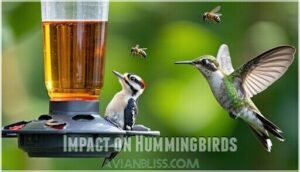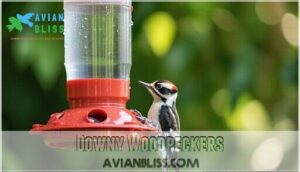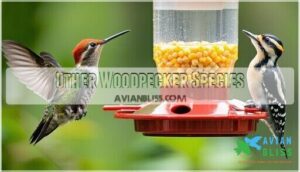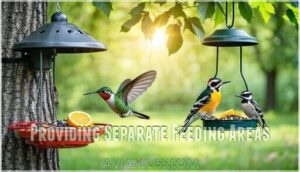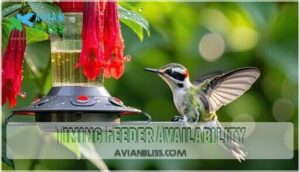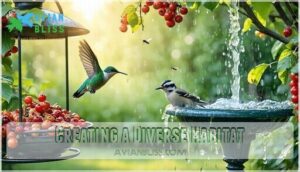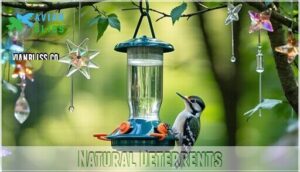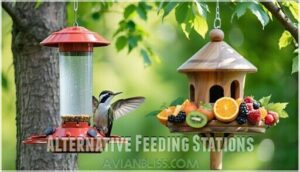This site is supported by our readers. We may earn a commission, at no cost to you, if you purchase through links.
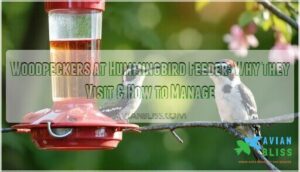
These clever birds love sweet nectar almost as much as hummingbirds do, and they’re not shy about helping themselves.
Sometimes, they’re also hunting for insects hiding near the feeder.
While it’s fun to see this backyard mash-up, woodpeckers can be a bit rough on plastic feeders and might make hummingbirds nervous.
You might spot Downy or Red-bellied woodpeckers joining the party.
There are simple ways to share your feeder without ruffling feathers—think separate feeding spots or timing tricks.
Curious how to keep the peace?
Stick around for more.
Table Of Contents
- Key Takeaways
- Woodpeckers Visit Feeders
- Woodpecker Feeding Behavior
- Impact on Hummingbirds
- Types of Visiting Woodpeckers
- Coexisting With Woodpeckers
- Frequently Asked Questions (FAQs)
- What other birds will eat out of a hummingbird feeder?
- What is drinking my hummingbird feeder at night?
- How to keep woodpeckers off your bird feeder?
- What is the number one predator of hummingbirds?
- Why do woodpeckers like my hummingbird feeder?
- How do I keep woodpeckers off my hummingbird feeder?
- Do red bellied woodpeckers drink from hummingbird feeders?
- Do red-bellied woodpeckers eat hummingbirds?
- Why do woodpeckers eat hummingbird feeders?
- Are woodpeckers attracted to hummingbirds?
- Conclusion
Key Takeaways
- Woodpeckers visit your hummingbird feeder for the sugar water, easy access to food, and the insects attracted by nectar.
- Their larger size and pecking can damage plastic feeders and scare off hummingbirds, causing competition at feeding spots.
- You can reduce conflicts by offering separate feeding stations, like suet or oriole feeders, and placing them at different heights or locations.
- Switching to feeders with smaller ports, adding natural deterrents, and timing feeder access help keep both woodpeckers and hummingbirds happy.
Woodpeckers Visit Feeders
You’ll often spot woodpeckers hanging around your hummingbird feeders, and there are three main reasons they can’t resist these sweet setups.
These resourceful birds discover that sugar water provides a quick energy boost, just like the natural tree sap they’d normally seek out in the wild.
Attraction to Sugar Water
Woodpeckers visit your hummingbird feeder because they’ve developed a serious sweet tooth for sugar water.
Sugar water is an irresistible treat for woodpeckers, turning your feeder into their favorite energy stop.
Like many birds, downy woodpeckers and other species crave the high-calorie nectar composition that matches their dietary needs.
This sugar preference isn’t surprising since woodpeckers naturally consume sweet tree sap and sugary fruits.
Your feeder becomes an irresistible calorie source.
Searching for Insects
While many woodpeckers hunt insects directly, they’re also drawn to hummingbird feeders by the abundance of bugs that gather around these sweet spots.
Your feeder becomes an insect lure, attracting flies, ants, and other small creatures that woodpeckers love to eat.
This bark foraging behavior extends to your backyard, where seasonal prey concentrates around sugar sources, making your feeder a convenient hunting ground for their diverse woodpecker diet.
Convenient Food Source
Your hummingbird feeder becomes the neighborhood’s go-to convenience store for woodpeckers.
With easy accessibility and high nutritional value, sugar water offers these birds a dietary supplement that requires minimal energy expenditure.
Unlike seasonal availability of natural nectar sources, your feeder provides consistent fuel year-round.
Smart woodpeckers recognize this reliable energy source beats hunting insects all day.
Woodpecker Feeding Behavior
When woodpeckers visit your hummingbird feeder, you’ll notice they use different techniques than the tiny hummers do.
These resourceful birds can’t hover like hummingbirds, so they perch on the feeder or cling to nearby surfaces while extending their long tongues to reach the sweet nectar.
Feeding Techniques
Using their specialized tongue morphology, woodpeckers adapt their drilling behavior when accessing hummingbird feeders.
Their long, barbed tongues extract sugar water efficiently from ports designed for smaller birds.
This dietary overlap creates competition at feeders.
You’ll notice woodpeckers gripping feeder perches while extending their tongues deep into nectar reservoirs, demonstrating remarkable food source adaptations that make bird deterrents challenging to implement effectively.
Time of Day Preferences
Early risers catch the best show! Woodpeckers exhibit distinct peak hours at your hummingbird feeder, with dawn visits starting shortly after sunrise.
These evening patterns include afternoon feeding spurts from 2-6 PM as birds prepare to roost. Midday activity drops substantially, though short feeding sessions occur.
Seasonal variation shifts timing with daylight changes, making woodpecker behavior predictable for bird feeding enthusiasts monitoring sugar water consumption.
This is especially true in the Southwest, where Gila woodpeckers frequently visit feeders.
Interaction With Hummingbirds
When woodpeckers arrive at your hummingbird feeder, expect some serious nectar defense drama.
Watch as these bold birds turn your feeder into a battleground, with hummingbirds zipping in for daring face-offs.
These larger birds often dominate feeding spots, creating territory disputes that send hummingbirds scrambling for cover.
- Feeder Competition: Woodpeckers’ size advantage means they control prime feeding positions
- Resource Scarcity: Limited sugar water access forces hummingbirds to find alternative sources
- Aggression Levels: Territorial woodpeckers may chase away smaller birds through intimidation tactics
This bird behavior creates real challenges for peaceful backyard feeding.
Understanding nectivorous feeding habits can help manage these interactions.
Impact on Hummingbirds
While woodpeckers at your hummingbird feeder might seem harmless, they can create real problems for both your equipment and the tiny birds you’re trying to attract.
Their larger size and persistent pecking behavior often damages delicate feeder parts, while their presence can scare away hummingbirds who prefer to feed without competition from bigger, more aggressive visitors, which can be a significant issue due to the persistent nature of these birds and the potential for delicate feeder damage.
Potential Damage to Feeders
Woodpeckers can wreak havoc on your hummingbird feeder’s structural integrity.
Their powerful beaks create holes in plastic feeder material, compromising spill prevention systems.
Here’s what typically gets damaged:
| Damage Type | Feeder Material | Repair Methods |
|---|---|---|
| Hole Creation | Plastic ports | Epoxy patches |
| Cracked bases | Glass/plastic | Replacement parts |
| Bent perches | Metal/plastic | Straightening tools |
Most bird feeder problems stem from woodpecker damage to feeding ports, making effective repairs essential for continued use.
They’re drawn to the sweet nectar, especially when natural sources are scarce.
Changes in Hummingbird Behavior
When woodpeckers claim your hummingbird feeder, these tiny dynamos don’t just roll over.
You’ll notice some fascinating behavioral shifts that show just how adaptable these feisty birds can be.
Here’s what happens when nectar competition heats up:
- Territory Defense – Hummingbirds hover nearby, darting aggressively at woodpeckers to reclaim their sugar water source
- Feeding Frequency changes as they adjust visit timing to avoid direct confrontation with larger competitors
- Migration Shifts toward alternative food sources when bird feeders become contested territory
These stress indicators reveal remarkable behavioral flexibility in your backyard’s smallest warriors; this is partly enabled by anatomical tongue adaptations.
Types of Visiting Woodpeckers
You’ll spot several woodpecker species at your hummingbird feeders, with each having different reasons for visiting.
The most common visitors include downy woodpeckers, red-bellied woodpeckers, and occasionally other species like Gila woodpeckers in southwestern regions.
Downy Woodpeckers
Among the most frequent visitors to your hummingbird feeder, downy woodpeckers stand out for their persistent behavior.
These small birds often dislodge plastic inserts designed to keep larger visitors away.
Reports from Monadnock and Connecticut confirm their regular appearances at sugar water stations.
Their downy diet naturally includes sweet fruits, making nectar appealing.
While feeder damage remains minimal, insert dislodging creates maintenance challenges for backyard bird enthusiasts.
Red-bellied Woodpeckers
Red-bellied woodpeckers show remarkable dietary adaptations, making hummingbird feeder visits common in their habitat preferences.
These medium-sized birds have strong bird identification features like barred backs and reddish crowns.
Their diverse bird feeding habits include nectar consumption alongside insects and fruits.
Regional variations affect their conservation status, with stable populations across eastern woodlands.
Unlike specialized species, red-bellied woodpeckers readily exploit artificial food sources, demonstrating flexible nesting habits near human settlements.
Other Woodpecker Species
Beyond downy and red-bellied woodpeckers, your hummingbird feeder might attract some surprising guests.
Yellow-bellied sapsuckers lap up leaking sap with specialized, brush-tipped tongues and occasionally visit feeders.
Northern flickers typically forage on the ground but sometimes sample nectar.
Out west, Gila woodpeckers and golden-fronted species demonstrate persistent Sapsucker Behavior, while Acorn Woodpeckers complement their Golden-fronted Diets with sweet treats.
Acorn woodpeckers are known to create communal acorn storage in granary trees.
Red-headed Woodpeckers rarely visit but add excitement when they do appear at your feeder.
Coexisting With Woodpeckers
You don’t have to choose between enjoying woodpeckers and keeping your hummingbirds happy.
With a few smart strategies, you can create a backyard where both species thrive without competing for the same feeder.
Providing Separate Feeding Areas
Creating separate feeding areas helps reduce competition between woodpeckers and hummingbirds at your existing hummingbird feeder.
Strategic feeder placement around your yard gives each species their preferred food source without territorial disputes.
Here’s how to set up effective bird feeding solutions:
- Install suet feeders 20-30 feet from hummingbird feeders to satisfy woodpecker preferences for high-fat foods
- Add oriole feeders with larger perches that accommodate woodpeckers while attracting birds with similar nectar preferences
- Position feeders at different heights – suet feeders on tree trunks, nectar feeders at eye level for ideal species separation
Consider exploring options for specialized woodpecker feeders to cater to their unique feeding behaviors.
Timing Feeder Availability
You can manage when woodpeckers visit your hummingbird feeder through strategic timing.
Early morning and late evening often see different bird feeding patterns due to natural migration patterns and weather impact.
Consider seasonal adjustments – removing feeders temporarily during peak woodpecker activity periods.
Regular feeder maintenance helps you monitor visitor patterns and implement these bird feeding tips for better bird feeder solutions when attracting birds.
To further enhance your feeder’s appeal, consider visible open areas to make it more inviting.
Creating a Diverse Habitat
Once you’ve figured out the best feeder timing, it’s smart to make your yard inviting for all kinds of backyard birds.
Boost bird diversity and keep woodpeckers busy by adding:
- Native Plants for food and cover
- Water Sources like birdbaths
- Shelter Options (shrubs, brush piles)
- Insect Diversity and Nesting Sites
A lively bird habitat keeps everyone happy.
Natural Deterrents
If you’ve made your yard bird-friendly, you might notice downy woodpeckers lingering at your hummingbird feeder.
Try natural repellents like predator scents or thorny barriers near feeders. You can also deter woodpeckers by using predator bird-like smells.
Visual deterrents—think shiny pinwheels or streamers—can spook them, too. Habitat modification, like trimming branches, helps with bird deterrence and even squirrel deterrence.
These tricks keep everyone happy, feathers unruffled.
Alternative Feeding Stations
Bird feeding stations can be a game changer.
Set up suet feeders, insect hotels, and fruit offerings well away from your hummingbird feeder.
Add seed options and water sources for variety.
These alternatives keep woodpeckers busy and less likely to bother your nectar-loving guests.
Consider offering specialized woodpecker blends to cater to their dietary needs.
Think of it as running a buffet: everyone gets their favorite dish, no nuisance wildlife invited, creating a woodpecker friendly environment.
Frequently Asked Questions (FAQs)
What other birds will eat out of a hummingbird feeder?
Funny how nature works—orioles, house finches, chickadees, and even thrushes sometimes sneak sips from hummingbird feeders.
They’re drawn by the sweet nectar, just like hummingbirds.
You might also spot butterflies and bees joining the feast!
What is drinking my hummingbird feeder at night?
You might’ve bats, raccoons, or even bears sneaking sips from your feeder at night.
These critters love sweet treats, and they’re not shy about raiding a free buffet while you’re asleep.
How to keep woodpeckers off your bird feeder?
If woodpeckers treat your feeder like an all-you-can-eat buffet, try adding a suet feeder nearby.
Use cages or baffles, and pick feeders with small ports.
Regularly clean up spilled seed to keep them moving along.
What is the number one predator of hummingbirds?
Cats top the list as the number one predator of hummingbirds.
If you’ve got outdoor cats nearby, those tiny birds don’t stand a chance.
Hawks, snakes, and even larger insects also pose a threat, but cats win.
Why do woodpeckers like my hummingbird feeder?
Imagine a sweet shop in the forest—your feeder is that candy store.
Sugar water isn’t just for hummingbirds; woodpeckers crave quick energy, too.
Their curiosity and taste for nectar draw them in for a treat.
How do I keep woodpeckers off my hummingbird feeder?
Try swapping your feeder for one with bee guards or smaller ports, hang it away from trees, and add a suet feeder nearby.
If all else fails, remember—everyone wants a sweet treat now and then!
Do red bellied woodpeckers drink from hummingbird feeders?
About 30% of feeder visitors in some areas aren’t hummingbirds—red-bellied woodpeckers are among them.
You’ll spot these clever birds sipping sugar water, especially if they’ve got a sweet tooth and easy access to your feeder.
Do red-bellied woodpeckers eat hummingbirds?
You don’t have to worry—red-bellied woodpeckers don’t eat hummingbirds.
They prefer insects, seeds, nuts, and fruit.
If you spot one at a feeder, it’s after sweet nectar, not the tiny birds themselves.
Why do woodpeckers eat hummingbird feeders?
Like kids at a candy store, woodpeckers just can’t resist the sweet nectar in hummingbird feeders.
They’re drawn to sugar water because it mimics the natural sap and fruit juices they love, making your feeder irresistible.
Are woodpeckers attracted to hummingbirds?
You won’t catch woodpeckers admiring hummingbirds—they’re not drawn to the birds themselves.
What really grabs their attention is the sweet nectar.
If a woodpecker visits, it’s after the sugar water, not the hummingbirds.
Conclusion
Like two chefs in one kitchen, woodpeckers at your hummingbird feeder can stir up a little chaos.
You’ve learned why these birds visit, how they behave, and the impact they’ve on your backyard guests.
With simple steps like offering separate feeding spots or adjusting feeder times, you can keep the peace.
Remember, a few changes go a long way.
Now you can enjoy both hummingbirds and woodpeckers without worrying about ruffled feathers or broken feeders, and this is a great way to maintain harmony.
- https://birdfact.com/articles/woodpecker-sleeping-habits-and-behavior
- https://www.birdwatchingdaily.com/beginners/birding-faq/when-are-birds-most-active-at-feeders/
- https://pubmed.ncbi.nlm.nih.gov/10983831/
- https://digitalcommons.usf.edu/cgi/viewcontent.cgi?article=3508&context=bird_observer
- https://lyricbirdfood.com/birding-hub/behavior/what-do-woodpeckers-eat/


